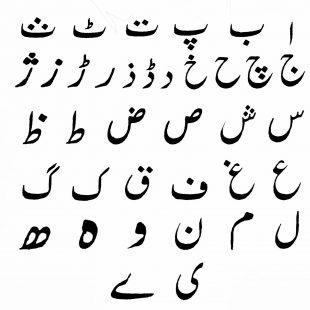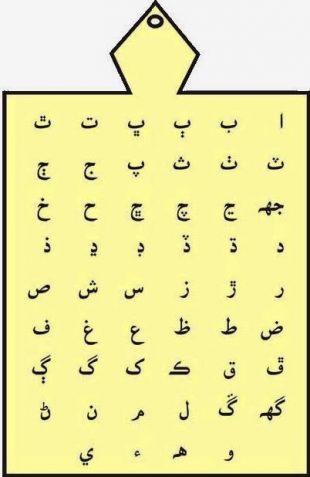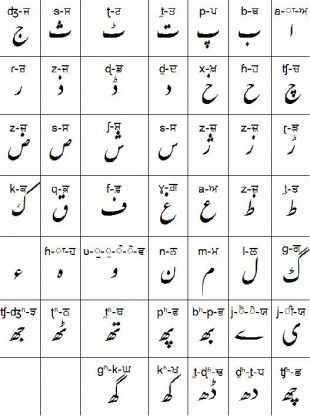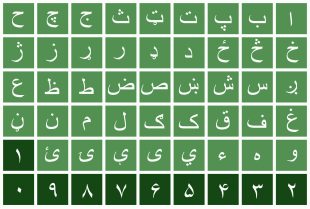Pakistan’s native languages have Perso-Arabic alphabets
Being a multinational and multi-lingual country, Pakistan could be portrayed as a bouquet of language-flowers, each of its flowers having a unique fragrance and richness of folk and contemporary literature.
As many as 24 languages are spoken in Pakistan, which include Urdu, Punjabi, Siraiki, Sindhi, Balochi, Brohvi, Pashto, Hindko, Shina, Dari and others however six of them – Punjabi, Sindhi, Siraiki, Balochi, Pashto and Urdu are main languages. Besides, the country has English as official language it inherited by the British who ruled Indo-Pakistan subcontinent for one and half a century till 1947.
Following is brief description of native languages, which interestingly, despite having their own scripts in the olden days, had turned to Perso-Arabic alphabet.
 Urdu Language: Although the Urdu is mother tongue of seven percent of the 200 million population of the country, it enjoys the status of national language since independence from British and is used as the lingua-franca.
Urdu Language: Although the Urdu is mother tongue of seven percent of the 200 million population of the country, it enjoys the status of national language since independence from British and is used as the lingua-franca.
The word Urdu originated from Turkic ‘Ordu’, which means ‘troops’, which later got Persianized as Zabān-i-Urdū (language of the camp) because it developed as a lingua franca between the occupying armies and the local people of the region around Delhi (India) after Muslim invasions from the 11th century onward.
The formation of the new language started with mixing of Khariboli, a Prakrit language spoken in North India, with Persian, Arabic, Turkic as well as Sanskrit words, and over the centuries it also adopted thousands of words from local and other foreign languages including English.
The Urdu script is a modification of the Persian alphabet known as Perso-Arabic, which itself is a derivative of the Arabic alphabet. With 39 basic letters and no distinct letter cases, the Urdu alphabet is typically written in the calligraphic Nastaʿlīq script, whereas Arabic is more commonly in the Naskh style, and is written from right to left. Thus Urdu considered as a Persianized standard register of the Hindustani language. In India, it is one of the 22 official languages recognized in the Constitution of India. Apart from specialized vocabulary, spoken Urdu is mutually intelligible with Standard Hindi, another recognized register of Hindustani. The Urdu variant of Hindustani received recognition and patronage under British rule when the British replaced the local official languages with English and Hindustani written in Nastaʿlīq script, as the official language in North and Northwestern India. Religious, social, and political factors pushed for a distinction between Urdu and Hindi in India, leading to the Hindi–Urdu controversy.
 Sindhi Language: Sindhi, the official language of Southern Sindh province of country, is also written in the Arabic script, but it belongs to the Indo-Aryan language family and over seventy percent of Sindhi words are of Sanskrit origin. It also absorbed thousands of words from Arabic, Persian, Turkic, English and other foreign languages. Centuries back, the historian Al-Biruni found Sindhi written in three scripts – Ardhanagari, Mahajani and Khudabadi, all of them variations of Devanagari. The British rulers however introduced officially the Arabic script retaining some native letters of alphabet. Thus the total number of its letters stood 52. The Sindhi alphabet has the peculiarity of pronouncing correctly any word of any language of the world.
Sindhi Language: Sindhi, the official language of Southern Sindh province of country, is also written in the Arabic script, but it belongs to the Indo-Aryan language family and over seventy percent of Sindhi words are of Sanskrit origin. It also absorbed thousands of words from Arabic, Persian, Turkic, English and other foreign languages. Centuries back, the historian Al-Biruni found Sindhi written in three scripts – Ardhanagari, Mahajani and Khudabadi, all of them variations of Devanagari. The British rulers however introduced officially the Arabic script retaining some native letters of alphabet. Thus the total number of its letters stood 52. The Sindhi alphabet has the peculiarity of pronouncing correctly any word of any language of the world.
In India, Sindhi is one of the scheduled languages officially recognized by the central government, though Sindhi is not an official language of any of the states in India.
Most Sindhi speakers are concentrated in Sindh province, certain parts of Punjab and Balochistan provinces, and in India, the Kutch region of the state of Gujarat, Rajasthan and in the Ulhasnagar region of the state of Maharashtra. The remaining speakers in India are composed of the Sindhi Hindus who migrated from Sindh and settled in India after the independence of Pakistan in 1947 and the Sindhi diaspora worldwide. The Sindhi and other native languages are struggling to be officially given the status of national language, as before the inception of Pakistan, Sindhi was the national language of Sindh.
 Siraiki Language: Like Sindhi, there were more than one scripts of Siraiki in the past. One was Multani script, a Brahmic script originating in the Multan region of Siraiki speaking people (part of Punjab and Sindh provinces). The script was used for routine writing and commercial activities. Multani is one of four Lahnda scripts whose usage was extended beyond the mercantile domain and formalized for literary activity and printing; the others being Gurmukhi (old Punjabi), Khojki (Marwari) and Khudawadi (Sindhi). Although Multani is now obsolete, it is a historical script in which written and printed records exist.
Siraiki Language: Like Sindhi, there were more than one scripts of Siraiki in the past. One was Multani script, a Brahmic script originating in the Multan region of Siraiki speaking people (part of Punjab and Sindh provinces). The script was used for routine writing and commercial activities. Multani is one of four Lahnda scripts whose usage was extended beyond the mercantile domain and formalized for literary activity and printing; the others being Gurmukhi (old Punjabi), Khojki (Marwari) and Khudawadi (Sindhi). Although Multani is now obsolete, it is a historical script in which written and printed records exist.
Today, the most common Siraiki writing system is the Perso-Arabic script, which has also been adapted for use on computers. Siraiki has a 45-letter alphabet including 39 of the Urdu alphabet and six letters unique to Siraiki and Sindhi, as both are considered sister languages. The Devanagari and Gurmukhi scripts, written from left to right, were used by Sikhs and Hindus. Though not used in present-day Pakistan, there are still emigrant speakers in India who know the Devanagari or Gurmukhi scripts for Siraiki.
Punjabi Language: It is also an Indo-Aryan language and the native language of the people of Punjab region, divided by British in 1947 among India and Pakistan.
In Pakistan it is written with a version of the Urdu alphabet known as Shahmukhi, having four additional letters. In Indian or eastern Punjab, Gurmukhi is used for writing. The Shahmukhi is a Perso-Arabic alphabet and is generally written in the Nastaʿlīq calligraphic hand, which is also used for Urdu.
Punjabi is the most widely spoken language in Punjab province and the 11th most widely spoken language in India.
Balochi Language: It is the principal language of the Baloch people spoken primarily in Iran, Pakistan and Afghanistan.
Balochi was not a written language before the 19th century and the Persian script was used to write Balochi wherever necessary. However, Balochi was still spoken at the Baloch courts.
British linguists and political historians wrote Balochi with the Latin script. Following the creation of Pakistan, Baloch scholars adopted Persian alphabet. The first collection of poetry in Balochi was published in 1951 and incorporated the Arabic Script. It was much later that a comprehensive guidance was published on the usage of Arabic script and standardized it as the Balochi Orthography in Pakistan and Iran.
 Pashto Language: Pashto is the language of the Pashtuns. It is known in Persian literature as Afghāni and in Urdu and Hindi literature as Pashto and Paṭhānī. Speakers of the language are called Pashtuns or Pakhtuns and Pathans. It is an Eastern Iranian language, belonging to the Indo-European family. It is one of the two official languages of Afghanistan. In Pakistan, it is the majority language of the province of Khyber Pakhtunkhwa and the northern districts of Balochistan province. The total number of Pashto-speakers is estimated to be 45–60 million people worldwide.
Pashto Language: Pashto is the language of the Pashtuns. It is known in Persian literature as Afghāni and in Urdu and Hindi literature as Pashto and Paṭhānī. Speakers of the language are called Pashtuns or Pakhtuns and Pathans. It is an Eastern Iranian language, belonging to the Indo-European family. It is one of the two official languages of Afghanistan. In Pakistan, it is the majority language of the province of Khyber Pakhtunkhwa and the northern districts of Balochistan province. The total number of Pashto-speakers is estimated to be 45–60 million people worldwide.
The Pashto alphabet is derived from the Perso-Arabic or Arabic script, with letters added to accommodate phonemes used in Pashto that are not found in Arabic. Pashto alphabet has 45 letters of which around 28 are Arabic.





















































